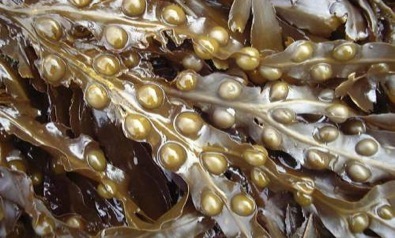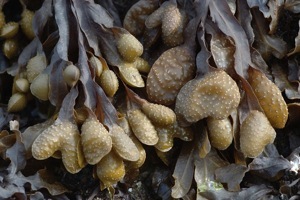Fucus vesiculosus: Edible Bladderwrack
Bladderwrack can wrack your brain.
Why? Because in some places it has bladders and is textbook perfect. And in others places it has few bladders and makes the pictures look wrong but also textbook perfect. Why? Because the numbers of bladders varies with wave action. Less waves mean more bladders, more waves, less bladders. But best of all Bladderwrack is nutritious, edible raw and cooked. It’s also medicinal, and like many things that have a medicinal applications, the flavor is strong.
Also called seawrack and rockweed, it can be used sparingly in soups and the like, depending upon your like or dislike of the flavor. It tastes like salty fish. Bladderwrack can also be dried for future use. On dehydration it turns black. (Slow roasting after drying with a little oil until brittle helps.) In large amounts it can be laxative. And of course, it can be eaten raw though try to get it in ocean waters not fertilized by human waste. It has also been used as fertilizer, being high in potassium, and also to smoke meat and fish.
Fresh it is green to orange to olive to brown, the brighter the fresher. Found between high and low tide, it lives three years and is firmly attached to the bottom, preferably to rocks usually in northern waters. To my knowledge, all Fucus are edible, but they vary significantly in description and will grow in the came locale. Consult you local expert. Sagassum used to be Fucus, such as the F. natans, but now has its own genus and is Sagassum natans (see the Sagassum entry.)
Fucus vesiculosus has been well-researched. It’s rich in dietary fiber, antioxidants and iodine. (In 1811 iodine was discovered in Fucus, the original source for it.) Bladderwrack lowers plasma cholesterol levels and has been used in anti-estrogen therapy, actually increasing the length of the menstrual cycle. (See Herb Blurb below.)
Fucus (FEW-cuss) comes from the Greek word “phykos” (FEE-kos) meaning seaweed. Vesiculosus (ves-see-kew-LOW-sus) is Latin and means with bladder. Natans (NAY-tanz) is floating. Fucus is sometimes incorrectly called kelp. In the past several seaweeds were burned to create soda ash which was called “kelp.” The seaweed kelp and the Fucus are different seaweeds.
Green Deane’s “Itemized” Plant Profile
IDENTIFICATION: A perennial attached sea-weed, with a hard flattish root, frond ranges from a few inches to four feet in length, and to an inch in width, flat with midrib throughout length, occasionally twisted like a spiral, branches often notched at the end. Air sacks vary from the size, from a pea to a marble, in pairs, at irregular intervals; sometimes 2 or 3 pairs are next to each other, rarely totally absent.
TIME OF YEAR: Year round
ENVIRONMENT: Shoreline, between high and low tides, prefers protected areas. Found in northern waters, in the United States North Carolina and central California northward. Usually collected at low tide.
METHOD OF PREPARATION: Raw or cooked, boiled or steamed, can be dried, strong flavored.
HERB BLURB
Bladderwrack contains: Iodine, algin, mucilage, bromine, sodium, potassium, lutein, zeaxanthin, chlorophyll, cellulose, mannitol, silicon, essential fatty acids, vitamin C, B-vitamins, beta-carotene, zinc, magnesium, selenium, manganese, iron, phosphorus, iodide, oleic acid, polyphenols, protein and fiber.





Would you please add me to your newsletter? I would really appreciate it.
I just stumbled onto your youtubes and website tonight. What a goldmine!! Thank you for all your hard work over the years putting this together.
I do have one question. Do you have a book available or anything in written format that can be purchased? If not, is there a book you can recommend that is anywhere near as comprehensive as what you’ve done on your website?
I look forward to hearing from you as well as reading your newsletters.
~~Michelle
Great website, just found it.
What might be also helpfull ( if you don’t already do) would be to ad with the description if there are any other similiar plants ect. that may be confused with, a cross refrence and if it could make you sick.
Thanks
When there is a significant opportunity to get identifications mixed up I do include the other plant.
I
am taking thyroxin tab every day ,can i take bladder wrack with this
I have no idea. I am a forager not a medical doctor nor an herbalist.
What parts of bladderwrack can you eat? All of it? I saw Les Stroud eat just only just the tips once on his show. Thanks Deane.
Hi Deane – thanks for this article. Wondering how best to keep the Bladderwrack – ie. in jar in fridge/out of fridge? I just harvested some yesterday as the snow was falling on the rocky coast… so it is FRESH!
It’s about 3-5 lbs. worth.
In the frig is fine… it likes cold places.
Hi, I’m new to this, do you have any suggestions for the best recipe and preparation of dried bladderwrack, also how do you best disguise the flavour as I hear it’s not very pleasant and how often do you take it?
I have gotten some dried, I usually soak it in fresh water for a while.. drain.. rinse then soak it again.
I am adding it to my orange chicken tonight but have had it soaked and raw in a “salad” using vinegar, Ginger, sesame, a little sweetener, and soy sauce.
Web MD says it’s likely not safe to eat. I read their article whilst visiting the toilet soon after consumption. Warning! It’s a laxative, but not
too strong. YMMV.
Then I found the earthy articles about the amazing benefits of bladdwrack. So I feel good about my choice.
Prepared about a cup, chopped, in with 2 cups of uncooked beans and brown rice and corn in the pressure cooker. Added half a can of quality tuna. Added soy sauce, tumeric, pepper. Came out really delicious.
Anyon using it as a tea?
Bought the dry bladderwrack and was wondering if I can just grind it and mix in in smoothies
we have 135 known species of seaweed in nc . so far i have only found 8 growing wild. all of the species in nc are edible and medicinal. badderwrack i have heard of used in algotherapy like other seaweeds. i have heard it was edible but never tried it or seen it outside of maine years ago.